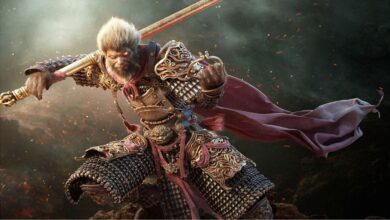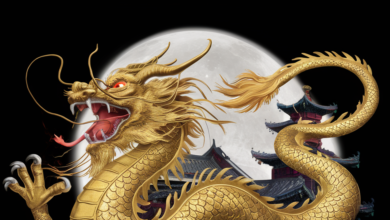
Table of Contents
In Chinese mythology, the dragon is a revered creature, and the legend of its nine sons is rich with symbolism and cultural significance. This article will delve into the origins, characteristics, and cultural impact of these nine mythical creatures, offering a detailed exploration of their roles and representations in Chinese culture.
Origins of the Nine Sons of the Dragon
The saying «The dragon has nine sons, each different from the other» reflects the idea that a father’s children do not necessarily follow his path; each has unique interests and destinies. This concept encourages the notion that children should be allowed to pursue their own paths without parental imposition. During the Ming Dynasty, Emperor Zhu Youcheng, curious about this saying, tasked his officials with identifying the names and characteristics of these nine dragon sons. Minister Li Dongyang, a learned scholar, compiled the list based on folklore, imagination, and literary creativity.
The Nine Sons of the Dragon
- Qiū Niú (囚牛)
- Appearance: Qiū Niú is depicted as a small yellow dragon with prominent scales and horns. He is often shown as an elegant and refined creature.
- Personality: This dragon son loves music and is often found in artistic depictions associated with musical instruments. He is considered to be the patron of musicians and is thought to bring harmony and joy through music.
- Cultural Significance: Sculpted on the heads of traditional Chinese stringed instruments, Qiū Niú symbolizes harmony and creativity in the realm of music. His presence is believed to enhance the musical experience and inspire those who play the instruments he adorns.

- Yá Zì (睚眦)
- Appearance: Yá Zì resembles a wolf or a fierce beast, with a formidable and aggressive demeanor. His features are sharp and menacing, often depicted with fangs and claws.
- Personality: Known for its aggressive nature and love for fighting, Yá Zì embodies the spirit of battle and protection. He is fearless and embodies the warrior spirit, always ready to defend and attack.
- Cultural Significance: Frequently carved on sword hilts and knife handles, Yá Zì serves as a talisman of power and protection for warriors. His image is intended to instill fear in enemies and provide courage to those who wield the weapons adorned with his likeness.

- Chāo Fēng (嘲风)
- Appearance: Chāo Fēng is similar to a bird or phoenix, often depicted in high and lofty places. He has a majestic and regal appearance, with wings spread wide and a proud stance.
- Personality: This son enjoys perching in high places and facing the wind, representing vigilance and the ability to foresee danger. He is a guardian who watches over from above, alert and ready to act.
- Cultural Significance: Chāo Fēng is commonly seen on the corners of roofs in ancient Chinese architecture, believed to ward off evil spirits and bring good fortune. His presence on buildings is thought to protect against natural disasters and malevolent forces.

- Pú Láo (蒲牢)
- Appearance: Pú Láo is a smaller dragon-like creature, known for its loud roar. He is often depicted with an open mouth, showcasing his powerful voice.
- Personality: Pú Láo has a penchant for loud noises and roaring, embodying strength and the power of sound. He is fearless and uses his voice to assert his presence and command respect.
- Cultural Significance: Often found as the decorative knob on large bells, Pú Láo amplifies the bell’s sound and is thought to protect against evil. His roar is believed to ward off negative energy and attract positive influences.

- Suān Ní (狻猊)
- Appearance: Suān Ní looks like a lion and is often associated with tranquility and contemplation. He has a serene and composed demeanor, often shown in a relaxed pose.
- Personality: This dragon son enjoys sitting quietly and is often depicted in serene and meditative poses. He embodies peace, calm, and the pursuit of inner balance.
- Cultural Significance: Suān Ní is frequently found on incense burners, symbolizing calm, reflection, and spiritual contemplation. His presence is believed to enhance the meditative experience and promote a sense of tranquility and focus.

- Bì Xià (赑屃)
- Appearance: Bì Xià resembles a tortoise, often depicted bearing heavy loads. He is sturdy and robust, with a strong shell that signifies endurance.
- Personality: Known for its strength and endurance, Bì Xià loves carrying heavy objects and symbolizes steadfastness. He is resilient and dependable, capable of bearing great weight and responsibility.
- Cultural Significance: Often depicted under stone tablets, Bì Xià represents the strength and resilience needed to support great weight, both physically and metaphorically. His image is used to signify the foundation and stability of important structures and documents.

- Bì Ān (狴犴)
- Appearance: Bì Ān has a tiger-like appearance, reflecting its fierce and authoritative nature. He is often shown with a regal and imposing stance, exuding power and command.
- Personality: This dragon son enjoys litigation and justice, embodying the principles of law and order. He is a protector of justice and fairness, always seeking to uphold the law.
- Cultural Significance: Bì Ān is often found on prison gates and courtroom decorations, symbolizing the enforcement of justice and the protection of legal proceedings. His presence signifies the authority and integrity of the judicial system.

- Fù Xì (负屃)
- Appearance: Fù Xì is depicted as a coiled dragon, often associated with scholarly pursuits. He has an elegant and intellectual appearance, with a composed and thoughtful expression.
- Personality: This dragon son has a deep appreciation for literature and learning. He embodies the virtues of knowledge, wisdom, and the pursuit of intellectual growth.
- Cultural Significance: Fù Xì is frequently seen on stone tablets and scrolls, representing knowledge, wisdom, and the pursuit of intellectual endeavors. His image is used to inspire and promote the value of education and learning.

- Chì Wěn (螭吻)
- Appearance: Chì Wěn has a fish-like body with a dragon’s head, often depicted on rooftops. He is graceful and fluid, with features that blend aquatic and dragon-like characteristics.
- Personality: This dragon son enjoys swallowing and is believed to protect against water-related disasters. He embodies adaptability and the power to overcome challenges related to water and fire.
- Cultural Significance: Chì Wěn is typically found on the ridges of roofs, where it is thought to guard buildings against fire and other calamities. His presence is believed to provide protection and ensure the safety of structures from natural elements.

The Birth Stories of the Nine Sons
Each of the nine sons has a unique origin story, further enriching their individual characteristics and cultural roles. Here are their detailed birth stories:
- Qiū Niú
- Birth: Born to a dragon and a female dragon, Qiū Niú inherited his love for music and became an emblem of musical harmony. His birth story emphasizes the importance of artistic talent and the cultural value placed on music.
- Yá Zì
- Birth: Resulting from a union between a dragon and a wolf, Yá Zì inherited a fierce and combative nature, symbolizing bravery and martial prowess. His origins highlight the significance of courage and strength in facing challenges.
- Chāo Fēng
- Birth: Born from a dragon and a large bird, Chāo Fēng developed a love for high places and danger, embodying vigilance and protection. His birth story underscores the value of watchfulness and the ability to foresee and prevent threats.
- Pú Láo
- Birth: Descended from a dragon and a frog, Pú Láo inherited a loud voice and is often used as a bell handle to amplify sound. His origins reflect the power of sound and its role in communication and protection.
- Suān Ní
- Birth: Born to a dragon and a lion, Suān Ní loves sitting quietly and contemplating, symbolizing peace and meditation. His birth story highlights the importance of inner peace and spiritual balance.
- Bì Xià
- Birth: Resulting from a dragon mating with a turtle, Bì Xià loves bearing heavy loads, representing endurance and strength. His origins emphasize the value of resilience and the ability to support and sustain under pressure.
- Bì Ān
- Birth: Born from a dragon and a tiger, Bì Ān loves litigation and justice, reflecting the principles of law and order. His birth story underscores the importance of justice and fairness in maintaining social harmony.
- Fù Xì
- Birth: Also from a dragon and a turtle, Fù Xì loves literature and learning, symbolizing scholarly pursuits and wisdom. His origins highlight the cultural reverence for knowledge and education.
- Chì Wěn
- Birth: Born from a dragon and a fish, Chì Wěn enjoys swallowing and is believed to protect against water-related disasters, guarding rooftops against fire. His birth story emphasizes the importance of adaptability and protection from natural disasters.
Cultural Impact and Symbolism
The nine sons of the dragon are deeply embedded in Chinese cultural heritage, each symbolizing different virtues and qualities admired in traditional Chinese culture. Their depictions in art, architecture, and literature serve not only as decorative elements but also as embodiments of various aspects of life and nature.
Art and Architecture
- Qiū Niú: Musical instruments adorned with Qiū Niú emphasize the importance of harmony and artistic expression in Chinese culture. These instruments are believed to bring joy and cultural enrichment to the community.
- Yá Zì: Weapons featuring Yá Zì highlight the valor and strength valued by warriors. They serve as symbols of protection and the warrior spirit, inspiring courage and resilience.
- Chāo Fēng: Roof corners decorated with Chāo Fēng symbolize vigilance and the protection of households from evil. These architectural elements are thought to safeguard inhabitants and ensure prosperity.
- Pú Láo: Bell handles shaped like Pú Láo amplify the resonance of bells, representing the power of sound in rituals and ceremonies. These bells are used in various cultural and religious practices to ward off evil and attract positive energies.
- Suān Ní: Incense burners with Suān Ní signify peace, reflection, and the importance of spirituality. These burners are used in temples and homes to create an atmosphere of serenity and contemplation.
- Bì Xià: Stone tablets supported by Bì Xià embody endurance and the steadfast support of tradition and history. These tablets are often inscribed with important cultural and historical texts, preserving knowledge for future generations.
- Bì Ān: Prison gates and courtrooms adorned with Bì Ān emphasize justice and the rule of law. These symbols reinforce the authority of legal institutions and the importance of upholding justice.
- Fù Xì: Stone tablets and scrolls featuring Fù Xì underscore the value of knowledge and scholarly pursuits. These items are revered in educational institutions and scholarly communities.
- Chì Wěn: Roof ridges decorated with Chì Wěn protect buildings, symbolizing guardianship against disasters. These decorations are thought to provide safety and security from natural and man-made threats.
Rituals and Traditions
In various rituals and traditions, the nine sons of the dragon play significant roles. For example, in festivals and ceremonies, sculptures and decorations featuring these creatures are used to invoke their protective and beneficial qualities. Their presence in temples, palaces, and other important structures highlights their importance in maintaining harmony, protection, and prosperity.
- Qiū Niú: During music festivals and cultural performances, Qiū Niú is invoked to bless the musicians and ensure a harmonious performance.
- Yá Zì: In martial arts tournaments and military parades, Yá Zì is honored as a symbol of bravery and strength, inspiring participants to showcase their best skills.
- Chāo Fēng: In rituals for household protection and safety, Chāo Fēng is invoked to guard against evil spirits and ensure the well-being of the family.
- Pú Láo: In ceremonies involving bells, such as temple rituals or community announcements, Pú Láo is invoked to enhance the bell’s sound and ward off negative energies.
- Suān Ní: In meditation and spiritual practices, Suān Ní is invoked to create a peaceful and reflective atmosphere, aiding practitioners in their pursuit of inner balance.
- Bì Xià: In rituals of endurance and strength, such as those involving heavy lifting or building foundations, Bì Xià is honored to provide the necessary resilience and support.
- Bì Ān: In legal and judicial ceremonies, Bì Ān is invoked to ensure fairness, justice, and the proper enforcement of laws.
- Fù Xì: In educational ceremonies and scholarly gatherings, Fù Xì is honored to inspire intellectual pursuits and celebrate academic achievements.
- Chì Wěn: In rituals for protection against natural disasters, Chì Wěn is invoked to safeguard homes and communities from harm.
Conclusion
The nine sons of the dragon are more than mere mythical creatures; they are symbols deeply ingrained in Chinese culture, each representing different aspects of life and nature. From their origins and characteristics to their cultural impact and symbolism, these dragon sons offer a rich tapestry of meanings and teachings that continue to resonate in Chinese art, architecture, literature, and traditions. Understanding the nine sons of the dragon provides a deeper appreciation of Chinese cultural heritage and the enduring legacy of these fascinating mythical figures.
The Cultural Connection: East and West
While the nine sons of the dragon are unique to Chinese culture, there are interesting parallels to be drawn with the Western zodiac signs. Both systems of mythology use animal symbols to represent different traits and characteristics. However, where the Chinese dragon sons are rooted in specific cultural values and roles, the Western zodiac encompasses a broader range of personality traits and life aspects.
- Aries (The Ram) and Yá Zì: Both represent strength and courage, with Aries being a sign of assertiveness and leadership, and Yá Zì embodying bravery and the warrior spirit.
- Taurus (The Bull) and Bì Xià: Both symbolize endurance and resilience, with Taurus known for determination and stability, and Bì Xià representing the steadfast support of great weight.
- Gemini (The Twins) and Fù Xì: Both are associated with communication and intellectual pursuits, with Gemini embodying adaptability and curiosity, and Fù Xì symbolizing scholarly wisdom.
- Cancer (The Crab) and Chì Wěn: Both are protectors of the home, with Cancer known for its nurturing and protective nature, and Chì Wěn guarding against natural disasters.
- Leo (The Lion) and Suān Ní: Both represent regal presence and tranquility, with Leo being confident and dominant, and Suān Ní symbolizing calm and meditation.
- Virgo (The Maiden) and Chāo Fēng: Both emphasize vigilance and attention to detail, with Virgo known for its meticulous nature, and Chāo Fēng representing watchfulness and protection.
- Libra (The Scales) and Bì Ān: Both symbolize justice and balance, with Libra known for its focus on harmony and fairness, and Bì Ān embodying the principles of law and order.
- Scorpio (The Scorpion) and Yá Zì: Both are associated with intensity and power, with Scorpio being passionate and transformative, and Yá Zì representing fierce combativeness.
- Sagittarius (The Archer) and Qiū Niú: Both are linked to exploration and cultural pursuits, with Sagittarius known for its adventurous spirit and love of knowledge, and Qiū Niú symbolizing artistic harmony.
- Capricorn (The Goat) and Bì Xià: Both are known for their strong foundation and perseverance, with Capricorn representing ambition and discipline, and Bì Xià symbolizing enduring strength.
- Aquarius (The Water Bearer) and Pú Láo: Both are associated with uniqueness and the power of expression, with Aquarius being innovative and forward-thinking, and Pú Láo representing the commanding presence of sound.
- Pisces (The Fish) and Chì Wěn: Both embody adaptability and fluidity, with Pisces being empathetic and intuitive, and Chì Wěn symbolizing the ability to navigate and protect against water-related challenges.
This comparison highlights how different cultures use mythical creatures and symbols to convey similar human values and experiences, enriching our understanding of global mythology and cultural expression.


